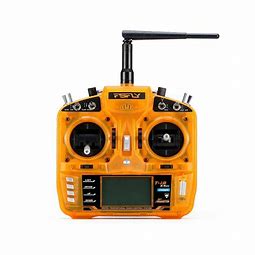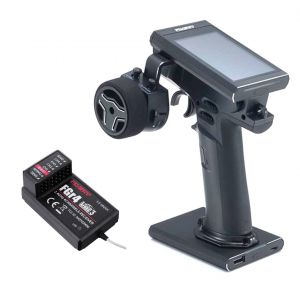Difference between revisions of "Radios"
(Names of radio features) |
(→Common problems: Added explanation and link to a correction tool.) |
||
| Line 33: | Line 33: | ||
*'''Compatibility:''' | *'''Compatibility:''' | ||
*'''Too Responsive:''' | *'''Too Responsive:''' | ||
| − | *'''Controls Reversed:''' | + | *'''Controls Reversed:''' The 'channel mixing' that allows a single transmitter stick to control forward/reverse motion as well as left/right rotation involves the coordination of multiple robot components. Errors in mixing set-up are common and may result in the robot failing to respond to stick inputs in the expected manner. These set-up errors can be difficult to identify and correct. The <Strong>[http://runamok.tech/RunAmok/mixfix4.html Team Run Amok 'Mixer Fixer]</Strong> will sort out your response symptoms and provide specific instructions to restore correct stick response. |
*'''Only one motor responds:''' | *'''Only one motor responds:''' | ||
*'''Robot hums or whines:''' | *'''Robot hums or whines:''' | ||
| − | *'''Robot won't stop moving:''' | + | *'''Robot won't stop moving:''' |
=Radio features and their uses= | =Radio features and their uses= | ||
Revision as of 19:32, 30 June 2021
Combat robots usually use R/C hobby radio equipment.[1] This includes:
- A transmitter (Tx), the part that the driver/operator of the bot holds. It sends your instructions to the robot.
- A receiver (Rx) module in the robot to receive your instructions and operate the devices on the bot.
- The receiver module has multiple outputs to connect to those devices. The standard device is a servomotor (servo) for moving things. You can also use adapters, such as ESCs, to make outputs for turning things (like wheels).
- There are combination Rx and ESC available for building small bots and other RC devices.
Many transmitters only work with a few models of receiver. The receiver must be bound (paired) with the transmitter for them to communicate. Most transmitters sold today can be set up to bind to multiple devices, so a single one can operate multiple robots, one at a time.
Follow directions to safely switch on or off your radio equipment without accidentally activating your robot’s devices.
Choosing a Radio
When choosing a radio there are many things to consider but there are three fundamental things that will drive your choice.
- Safety: Runaway robots can be dangerous, so it is critical that your radio system properly handles what is known as a Failsafe situation. When the robot loses signal from the transmitter, the receiver must stop all movement and turn off weapons. (Many events require that the radio be turned off while people are in the arena to insure that the robot isn't moved accidentally by a person.) Not all radios have a failsafe feature, and many must be set up or programmed for the correct behavior. For instance, aircraft receivers may continue flying or attempt to land if the transmitter signal is lost.
- Form factor: You may have a preference on the form factor of your radio transmitter. The pistol-grip types have a throttle trigger and steering wheel, and may be easier to learn, though some people feel they lack fine control. Dual-stick radios are generally the most flexible and often have switches which can be programmed for special operations. Transmitters in the shape of game controllers are increasingly common; you may find this type to be more familiar to operate, and the controls may require very short movements. With time and enough practice, the differences between types may become insignificant.
- Functionality: Each robot's requirements are different. A simple wedge robot may only need two channels with a third channel enabling a weapon, but some robot designs need even more channels or other radio programming features. If your ESC doesn't have built-in mixing you'll need to find a radio that can do tank-steering Mixing.
If you are looking to purchase a radio, take a look at the list of radios that are known to be suitable for robot combat.
Common problems
Since the radio receiver passes signals to the robot's Electronic Speed Controllers to drive the robot's functions, it can sometimes be difficult to determine if the problem is with the radio or the ESC. To make troubleshooting easier, solutions to common problems that affect the whole system are described here.
Team Run Amok's Ask Aaron site is a good resource for additional information and troubleshooting.
This section needs additional details.
- Failsafe: What does your receiver do when it loses its signal? Some inexpensive radio systems will act unpredictably with signal loss, while other systems will continue on with their last good signal until they can reconnect. This 'continue' behavior can be useful for some RC systems but can be dangerous for robot combat. Check out the radio list for systems that can be set up to failsafe appropriately. If your radio system can't failsafe then most events will not allow it, especially for bots that have active weapons. It's important to remember that often the radio defaults will not work correctly and you will need to adjust them.
- Signal Loss:
- Not Binding / Connecting:
- Compatibility:
- Too Responsive:
- Controls Reversed: The 'channel mixing' that allows a single transmitter stick to control forward/reverse motion as well as left/right rotation involves the coordination of multiple robot components. Errors in mixing set-up are common and may result in the robot failing to respond to stick inputs in the expected manner. These set-up errors can be difficult to identify and correct. The Team Run Amok 'Mixer Fixer will sort out your response symptoms and provide specific instructions to restore correct stick response.
- Only one motor responds:
- Robot hums or whines:
- Robot won't stop moving:
Radio features and their uses
If you decide to study all the features of a radio control system, you'll run into language peculiar to those hobbies. Here is a guide to some of the abilities and specs your transmitter and receiver may have, and how they might be useful in robot combat.
- Number of channels refers to the number of devices that can be operated remotely. Most modern radios have 6 or more, which is fine. A 3 channel truck transmitter might be adequate for a pusher bot only.
- Channel mixing can break out the motion of 1 stick into 2 motors, allowing 1-stick steering. See Radios/Mixing.
- Model memory stores a list of robots; they can all have different settings, and you can control any of them with one transmitter.
- Reversing means the transmitter can command motion in the opposite direction. Some transmitters can be programmed to reverse direction of motion with a switch; if your bot still moves while upside-down, flicking this switch lets you operate the bot with the same stick motions instead of with backwards motions.
- Trim adjusts the center point of controls. In particular, when a joystick is released and springs back to the center position, proper trim means that the Tx will send a neutral signal.
- Sub trim adjusts the center point of receiver outputs. You might need that to make sure ESCs shut off when the Tx sends a neutral signal, or to set a default weapon position.
- Dual rate (rate limit) lets you switch on or off a lower-speed, more sensitive motion mode. This could be used to set a speed limit on a "hot" high-speed bot, but still allow a skilled driver to push it to the limit.
- End point adjust sets travel maximums for servos. For example, if your bot has a servo-operated long-arm lifter, this could be used to set the perfect level for the tip of the lifter to glide across the arena floor.
- Exponential rate (expo) changes the response curve of your joysticks. Changing from linear to exponential response could help you move or steer with precision using short joystick actions, with rapidly increasing speed the farther you push the joystick.
- Telemetry lets the transmitter receive data from the receiver, and display it or give an audio signal. The most advanced combat robots report things like battery status, overheating parts, electronic overload, and other useful info from the bot to help the team shape their strategy during a fight.
- Trainer features let you link two transmitters together. This was originally designed to allow for a pilot and his instructor to share the task of flying aircraft. In combat robotics, the trainer feature could be used to let two people control a bot with different roles (e.g., driver & weapon) using two transmitters. (While some bot teams use trainer features, others have two or more separate, non-linked sets of transmitters and receivers for the same purpose.)
Programming a radio
TBD

